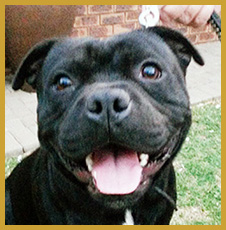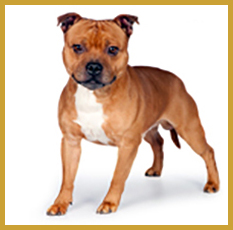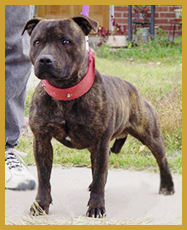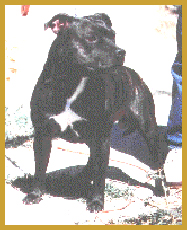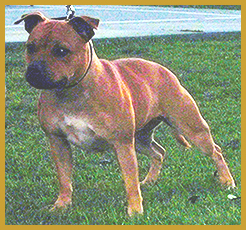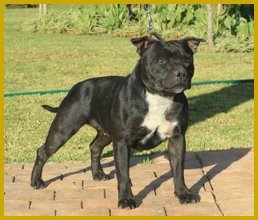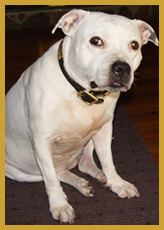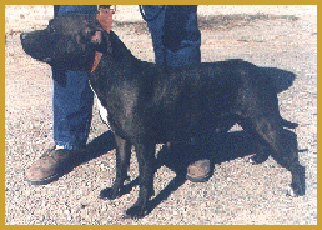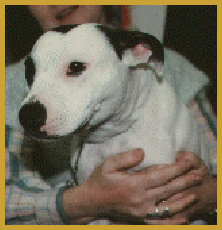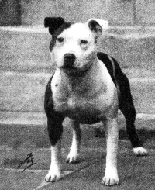The Staffordshire Bull Terrier breed of dog was recognized by the Kennel Club of England in 1935. This was the first official recognition of the Stafford as a Breed of dog.
But before recognition, a club had to be formed and a Standard drawn up. From John F. Gordon's book "The Staffordshire Bull Terrier" published in 1971 we have the following historical commentary found on page 39 of that publication.
Making of the Standard
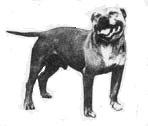
Making the Standard was one of the first duties that fell to the SBTC. It was gone into thoroughly by a body of experts, men with years of experience and ownership in the breed. Two good current dogs were set up as excellent examples of the breed. They were Harry Pegg's Joe (Fearless Joe) and Mrs. J. Shaw's Jim (Jim the Dandy),
the former a fawn, the latter a brindle. Their anatomy and structural points were examined, and a lot of old sketches, prints and photographs discussed. It will be understood that in any breed, provided a number of examples are available, some features will be more or less uniform or common to the majority. Assuming that these characteristics are sound ones they can then be accepted as being typical of the breed. Some difficulties were at first experienced in the discussions, for a wide range of types and sizes existed in Staffords in those days. It was natural that those who owned the big bulldoggy types claimed theirs were the right type, while those with the long-muzzled lightweights supported theirs. It needed a lot of tact and discretion on the part of club officials to convince these enthusiasts who was right and who was wrong, while still retaining their interest, to say nothing of their memberships. Clearly, the Stafford as a fighting dog had natural physical attributes expected of a combatant canine. Where these were found common to a number of dogs they were accepted as desiderata in the breed, and eventually a Standard was formulated and passed to the Kennel Club for approval. For some time argument was rife in Staffordshire towns like Walsall, Darlaston, and Cradley Heath, each of which had different ideas as to what constituted a good Stafford. However, as their opinion in the main of a good Stafford was one that fought and won, they were hardly qualified to pass worthwhile comment of any kind on what constituted a good type for exhibition.
1935 Standard - the Original (click)
More on The Stafford Standard
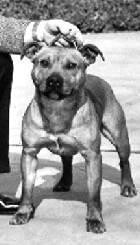
Brutus - Bandits Firestreak Red Rover
The first Staffordshire Bull Terrier Club in the United States, the SBTC/USA, proposed a standard in 1964. This was the United States fanciers initial attempt to gain recognition by the AKC.
SBTC/USA Proposed Standard (click)
AKC Staffordshire Bull Terrier Breed Standard
The Staffordshire Bull Terrier breed of dog was admitted to registration in the American Kennel Club Stud Book on October 1, 1974. This was the first time that the Stafford was officially recognized in the United States as a Breed of dog.
The current AKC Staffordshire Bull Terrier Breed Standard was approved November 14, 1989, and was effective January 1, 1990.
AKC Standard (click)
What is a Breed Standard?
A good answer to this question was given in the book "The Staffordshire Bull Terrier in America" edited by Steve Eltinge, and was as follows:
An official standard is a blueprint for a breed of dog. Every breed recognized by the United Kennel Club and the American kennel Club has a standard. Some standards (like the one for Staffordshire Bull Terriers) are simple; others (like the Great Dane Standard) contain thousands of words detailing virtually every aspect of the dog's conformation. These standards or "blueprints" describe an ideal to which breeders attempt to conform. It is the responsibility of UKC and AKC judges to thoroughly familiarize themselves with the standards for each breed that they are approved to judge. Judges must then evaluate exhibitors' dogs according to the degree to which each dog represents the Official Standard.
The Official Standard for the Staffordshire Bull Terrier, like all other standards, is written from a positive perspective. Pure-bred dog standards describe what is desirable and correct. Virtue, not fault, is emphasized. Standards mention faults as well as disqualifications but the intent is to describe the ideal. Thus, each breeder has a model or framework from which he or she may form a mental picture of the ideal dog. It is the task of the judge to grade the efforts of the breeders in attendance through a system of awards. This is a vital process for those involved in raising purebred dogs. Without standards, dog shows, and judges, the identity of all breeds would probably soon be lost.
Since there are no perfect dogs in any breed, illustrated standards are usually presented graphically. This allows the artist to selectively add the best parts of several dogs to a composite drawing. In this chapter photographs are used to illustrate the Official Standard. Although not perfect in every regard, the dogs depicted here demonstrate the ideal according to each particular section of the Standard. Photos and drawings are also used to illustrate faults.
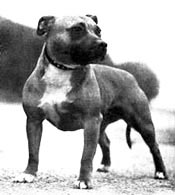
The Official Standard for the Staffordshire Bull Terrier was accepted by the American Kennel Club in 1974. In 1975, the first Staffordshire Bull Terriers were shown in the Terrier Group at AKC shows.
The one thing that a Standard cannot describe is the intangibles of spirit, intelligence, heart and tenaciousness. The Stafford is more than the written standard and there is a lot more to him than can be seen by a show judge and his identity is more than can be seen in the show ring.
We have attempted to illustrate the points of the breed standard with graphics and photos. The intangibles we illustrate with anecdotes, history and other articles within this cyber-publication.
And then we have a very interesting comparison of the 1935, 1948, and 1987 Standards and how the standards changed. Or as Juanit Hobbs describes it: "And that, my friends, is, believe it or not, a short description of what has happened to our Breed Standard since 1935!"
A history and discussion of the Standard (click)
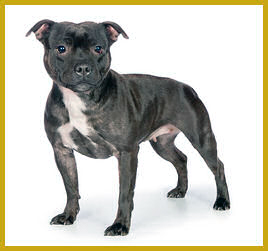
Rioghal Coco Chanel - Kimball Studios photo shoot.
